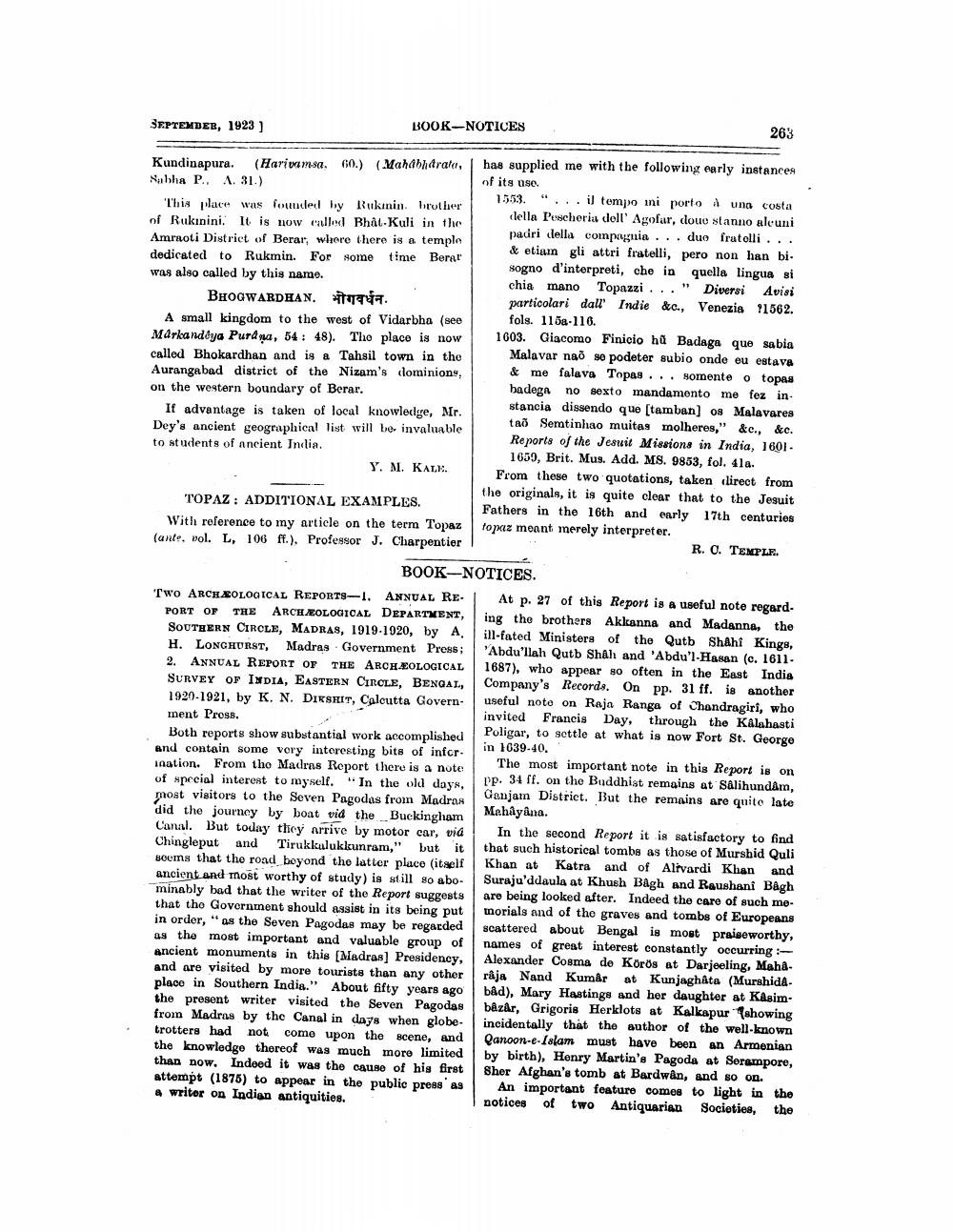________________
SEPTEMDER, 1923)
BOOK-NOTICES
263
Kundinapura. (Hariamsa, 60.) (Mahabharata, has supplied me with the following early instances Nabha P. A. 31.)
of its use.
1.553. "... il tempo ini porto a una costa This place was founded by Rutkinin. brother
(lella Pescheria dell' Agofar, doue stanno alcuni of Rukinini. It is now called Bhål-Kuli in the
padri clella compagnia ... due fratelli ... Amraoti District of Berar, where there is a temple
& etiam gli attri fratelli, pero non han bidedicated to Rukmin. For some time Berar
sogno d'interpreti, che in quella lingua si was also called by this name.
chia mano Topazzi ..." Diversi Avisi BHOGWARDHAN. a.
particolari dall' Indie &c., Venezia ?1562. A small kingdom to the west of Vidarbha (see fols. 1158-116. Markandeya Purana, 54 : 48). The place is now 1003. Giacomo Finicio hů Badaga que sabia called Bhokardhan and is a Tahsil town in the Malavar nað se podeter subio onde eu estava Aurangabad district of the Nizam's dominions, & me falava Topas ... somente o topas on the western boundary of Berar.
badega no sexto mandamento me fez in.
stancia dissendo que tamban) og Malavares If advantage is taken of local knowledge, Mr.
tað Semtinhao muitas molheres, &c., &c. Dey's ancient geographical list will be invaluable
Reports of the Jesuit Missions in India, 1601 - to students of ancient India.
1659, Brit. Mus. Add. MS. 9853, fol. 4la. Y. M. KALE.
From these two quotations, taken (lirect from
the originals, it is quite clear that to the Jesuit TOPAZ : ADDITIONAL EXAMPLES.
Fathers in the 16th and early 17th centuries With reference to my article on the term Topaz topaz moant merely interpreter. (ante, vol. L, 106 ff.), Professor J. Charpentier
R. O. TEMPLE. BOOK-NOTICES. TWO ARCHXOLOGICAL REPORTS-1. ANNUAL RE: At p. 27 of this Report is a useful note regard. PORT OF THE ARCHAEOLOGICAL DEPARTMENT, | ing the brothers Akkanna and Madanna, the SOUTHERN CIRCLE, MADRAS, 1919-1920, by A ill-fated Ministers of the Qutb Shahi Kings, H. LONGHURST, Madras Government Press; 'Abdu'llah Qutb Shah and 'Abdu'l-Hasan (c. 16112. ANNUAL REPORT OF THE ARCHÆOLOGICAL 1687), who appear so often in the East India SURVEY OF INDIA, EASTERN CIRCLE, BENGAL, Company's Records. On pp. 31 ff. is another 1920-1921, by K. N. DIKSHIT, Calcutta Govern- useful note on Raja Ranga of Chandragiri, who ment Pross.
invited Francis Day, through the Kalahasti Both reports show substantial work accomplished
Poligar, to settle at what is now Fort St. George
in 1039-40. and contain some very interesting bits of infcr. ination. From tho Madras Report there is a note
The most important note in this Report is on of special interest to myself. "In the old days,
up. 34 ll. on the Buddhist remains at SalihundAm, most visitors to the Seven Pagodas from Madras
Ganjam District. But the remains are quite late did the journey by boat vid the Buckingham
Mehåyåna. Canal. But today they arrive by motor car, via
In the second Report it is satisfactory to find Chingleput and Tirukkulukkunram," but it that such historical tombs as those of Murshid Quli sooms that the road beyond the latter place (itself Khan at Katra and of Alivardi Khan and ancient and most worthy of study) is still so abo- Suraju'ddaula at Khush Bagh and Raushani Bagh minably bad that the writer of the Report suggests are being looked after. Indeed the care of such methat the Government should assist in its being put morials and of the graves and tombs of Europeans in order," as the Seven Pagodas may be regarded scattered about Bengal is most praiseworthy, as the most important and valuable group of names of great interest constantly occurring S Ancient monuments in this Madras] Presidency, Alexander Cosma de Körös at Darjeeling, Mahaand are visited by more tourists than any other råja Nand Kumar at Kunjaghâta (Murshidaplace in Southern India." About fifty years ago bad), Mary Hastings and her daughter at Kasimthe present writer visited the Seven Pagodas bêzêr, Grigoris Herklots at Kalkapur (showing from Madres by the Canal in days when globe. incidentally that the author of the well-known trotters had not come upon the scene, and Qanoon-e-Islam must have been an Armenian the knowledge thereof was much more limited by birth), Henry Martin's Pagoda at Serampore, than now. Indeed it was the cause of his first Sher Afghan's tomb at Bardwân, and so on. attempt (1875) to appear in the public press as An important feature comes to light in the a writer on Indian antiquities.
notices of two Antiquarian Societies, the




